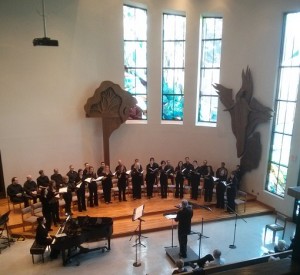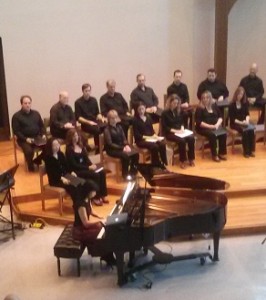American Minimalists Concert at Cal Lutheran
 The Minimalist Jukebox set up shop at Cal Lutheran on Sunday, April 13, 2014 for a concert titled ‘American Minimalists’, featuring Gloria Cheng and the Areté Vocal Ensemble. The Samuelson Chapel was comfortably filled for this event, which is connected with the Los Angeles Philharmonic Green Umbrella concert series. This performance was also designated the CLU Suzanne Freeman Memorial New Music Concert.
The Minimalist Jukebox set up shop at Cal Lutheran on Sunday, April 13, 2014 for a concert titled ‘American Minimalists’, featuring Gloria Cheng and the Areté Vocal Ensemble. The Samuelson Chapel was comfortably filled for this event, which is connected with the Los Angeles Philharmonic Green Umbrella concert series. This performance was also designated the CLU Suzanne Freeman Memorial New Music Concert.
The concert opened with Knee Play I (1976) by Philip Glass from his iconic opera Einstein on the Beach. The Knee Plays are short interludes devised to cover scenery and costume changes during the opera but each contains its own unique emotional trajectory. Knee Play I opens with a sequence of three long, low tones in the synthesizer that are slowly repeated. A sung counting sequence “1, 2, 3, 4…” starts while the Areté Vocal Ensemble filed onto the stage. Narration was added, and although indistinct, this heightened the contrast between the repeated low tones in the synthesizer and the counting in the voices. The motion of the singers, the text and the music combined to evoke that hurried contemporary lifestyle where we are likely to be missing the important undercurrents. The sudden ending of this piece found the thirty-plus members of Areté in place on stage.
Know what is above you (1999) by Steve Reich was next, and this featured a high, airy blend of sound from the voices of Jill Walker, Angela Card, Lisa Wall-Urgero and Ronni Ashley. The text is taken from the Talmud. A steady beat underneath from two small hand-held drums keeps the piece pulsing forward as the voice lines separate and interweave forming interesting harmonies. As the piece progresses the percussion breaks into more complex patterns, nicely complimenting the movement in the voices. Although the only Reich piece in the program, and not a long work, Know what is above you is good example of what the music of Steve Reich is about and fit into the programming of this concert precisely.
Escape, from Alcatraz (1982) by Ingram Marshall followed and this was performed by Gloria Cheng. The piece played for this concert was arranged for piano and electronic processing by Samuel Carl Adams in 2014, and this was the premiere performance. The opening series of notes is deceptively sunny and optimistic, like a summer morning on San Franciso Bay, but soon turns darker and more dramatic. A deep rumbling in the lower registers builds like an angry sea and as the piece continues an agitated feeling in the higher notes is reminiscent of frothy white caps. Ms. Cheng played with a good balance of precision and emotion throughout. This piece is one of a series and paints a portrait of Alcatraz that evokes a definite sense of its place.
Knee Play 4 by Glass was next and this was similar to the opening piece but with a faster tempo and a repeating arpeggio in the synthesizer. Instead of counting, male voices sang ‘do re mi fa so’, in various syncopated patterns. This turned slower, proceeding more smoothly and gently. The placidity of the singing covered an undercurrent of uncertainty ,and this subtle balance was effectively realized by Areté .
 A solo piano piece by Gavin Bryars followed, Ramble on Cortona (2010) performed by Gloria Cheng. The piece opens with quiet chords and has an almost church-like feel. Gavin Bryars has an extensive collection of 13th century music and this piece is inspired by manuscripts from Cortona, Italy. The pace is slow and deliberate with an introspective, nostalgic color. Long melodic lines and complex harmonies filled with emotion were played with great sensitivity by Ms. Cheng. At the conclusion, a full ten seconds of silence elapsed before the audience applauded.
A solo piano piece by Gavin Bryars followed, Ramble on Cortona (2010) performed by Gloria Cheng. The piece opens with quiet chords and has an almost church-like feel. Gavin Bryars has an extensive collection of 13th century music and this piece is inspired by manuscripts from Cortona, Italy. The pace is slow and deliberate with an introspective, nostalgic color. Long melodic lines and complex harmonies filled with emotion were played with great sensitivity by Ms. Cheng. At the conclusion, a full ten seconds of silence elapsed before the audience applauded.
Two pieces by David Lang were next, I want to live (2005) and Where the bee sucks (2012). I want to live starts with these words in the soprano and this eventually becomes a syncopated round in two parts. Further on it slows into smooth, gentle harmonies and the singing by Areté was quite lovely here. The piece then picks up again with a stronger rhythm and a more plaintive feel. This music is scored for female voices and was part of a longer work originally written for Bang on a Can in New York. Where the bee sucks, for tenor and piano followed immediately and this has a pleasantly bluesy feel and a high tenor line that was nicely negotiated by Sterling Koch. Where the bee sucks comes from a line by Shakespeare and was commissioned for the opening of the National Opera Center.
Knee Play 5 by Philip Glass followed and was sung by Areté. This began in similar fashion to the opening piece, with counting in the vocal parts and low repeating tones in the synthesizer. The morphs into a smooth series of sustained harmonies and counterpoint in the higher register of the synthesizer. Narration, in the form of a lovers conversation on a park bench, was added and this formed a distinctively human connection after the busy feel of the counting voices. Of the three Knee Plays in this concert this piece had the strongest emotional pull and the text is quite moving.
The next piece was Continuum (1968) by György Ligeti, performed on the harpsichord by Gloria Cheng. This began with a series of high, fast trills that were soon joined by others in the lower registers. A line of singular notes arcs above this dense texture resulting in a dramatic and complex feel. Towards the conclusion the trills moved up the scale increasing the tension like a wire being stretched – until the music abruptly ends. This challenging piece was a reminder of how technically accomplished the playing Ms.Cheng can be, and the beautifully expressive Ramble on Cortona from earlier illustrated just how far her talent extends.
Three sections of an opera by John C. Adams followed, I Was Looking at the Ceiling and Then I Saw the Sky (1995). This piece is comprised of a series of individually sung stories about the 1994 Northridge earthquake. The first of these was Consuelo’s Dream, sung by Heidi Valencia Vas and this was both lovely and dramatically effective. Next came Leila’s Song: Alone (Again or at Last) and the strong dynamics and emotions were nicely sung by Molly Stilliens. The final piece, Dewain’s Song of Liberation and Surprise was powerfully sung by Scott Brodie whose booming voice easily reached the top row of the balcony. The accompaniment throughout by Jessica Helms was flawless and provided just the right support for the soloists. This music is as close as Adams comes to the conventional opera or musical, and is similar to the concert repertoire of Areté.
The concert concluded with Vessels from the film music of Koyaanisqatsi: Life out of Balance (1982) composed by Philip Glass. A clip from the film was also projected on the wall and those familiar with Koyaanisqatsi were not disappointed. The singing of Areté was spot on and Gloria Cheng played the furiously fast synthesizer sections with amazing precision and accuracy. As I watched, her hands and fingers seemed almost frozen with only the slightest movement needed to create that incredible blizzard of notes. This was a fine ending to a concert that offered a wide range of minimalist music in carefully prepared and easily digestible pieces. The strong effort was received with sustained applause.